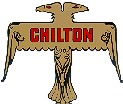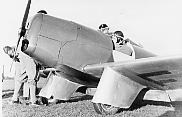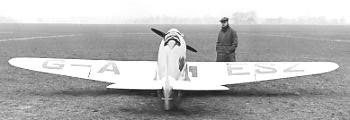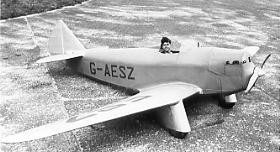

Chilton Aircraft Co
Hungerford Berkshire UK
our thanks to
www.nerou.pfanet.co.uk
The
Chilton Monoplane is probably the only aircraft to have been designed at
De Havilland's not to bear that Company's name. It was designed by two
very bright young students whilst at the De Havilland Technical School,
the Hon. A. H. Dalrymple, son of the Earl of Stair and Mr A. "Reggie".
Ward, son of the Hon. Sir John Ward. hence the initials D.W.1. The design
was something of a freelance exercise and was carried out at Hatfield
during 1935 and early '36 under the watchful eye of Marcus Langley (Chief
Design Instructor 1932-39), to the very highest of standards. The Miles
Hawk was the latest thing at the time and Miles geometry influenced the
fuselage design, including the Miles system of using office staples in
place of gimp pins but constructional standards were of a higher order
corresponding to the best at De Havilland's.
On leaving De Havilland's, Ward and Dalrymple formed Chilton Aircraft,
then persuaded their wood-working instructor at De Havilland's, Fred
Luscombe to come and work for them. Fred commenced work at Chilton Lodge
on 18th May 1936 and built a test wing and a mock-up of the forward
fuselage before commencing work on the prototype, this was registered G-AESZ
in January 1937. The aircraft was constructed in wooden building specially
erected for the purpose in the grounds of Chilton Lodge, the stately home
of Wards parents set in a extensive grounds at Chilton Foliate, Berkshire.
The choice of engine for such a machine was very limited, the Carden-Ford
was selected as being the most suitable, being an aero adaptation of the
Ford 10 side-valve motor car engine of 1172cc capacity cleverly modified
with dual magnetos by Sir John Carden, primarily as a power plant for the
Flying Flea.

The engine developed 32 h.p. @ 3,300 r.p.m.
was reliable but with its cast iron cylinder bock and water cooling it
presented a rather grim power to weight ratio of 5.5 lbs per h.p.
Dalrymple described it as "sheer weight" and having lifted one of these
engines myself I know exactly what he meant! Carden Aero Engines was
formed in 1935 by Sir John V. Carden Bt., Technical Director of
Vickers-Armstrong, who's name is associated with Carden-Lloyd Tanks,
Tractors and Carden Light Cars. Sadly Sir John was killed in an airliner
crash in December 1935, the company was then taken over by Carden-Baynes
Aircraft Ltd. In 1937 it was acquired by Chilton Aircraft, to produce
engines for its own needs.
The Carden-Ford engine was bolted directly on to wooden bearers which were
simply an extension of the fuselage sides, an idea obviously inspired by
the early wooden DH Moths. The prototype was completed towards the end of
March 1937 and it was taken to Whitney Aerodrome in Oxfordshire for its
flight trials. These was carried out by Ranald Porteous, who had been a
fellow student at De Havilland's, he subsequently became Auster Aircraft's
test pilot during the 1940s and 1950's and was famous for his exhilarating
displays. The Chilton made its first flight on the 16th April 1937 and
though the aircraft flew faultlessly, the engine overheated as the cowling
aperture for the radiator required enlargement, however the cowling was
quickly modified and no further problems were encountered.

After the prototype came the first production
machines, G-AFGH and G-AGFI, apart from small differences in the cowlings
& colour schemes, the three machines looked very much alike. Most of the
subsequent flying took place from the private landing ground of the Earl
of Cardigan at High Trees on the edge of the Savernake forest just south
of Marlborough. The machines were hangered in the Earl's private hanger, a
large substantial building adapted to take an Avro 504N that was no longer
kept there.
The following is a compilation of extracts from letters from the late
Harold Holdsworth, who joined Chilton Aircraft in early '39, his
recollections give a fascinating insight and flavour of the times, he
writes thus:-
"I accepted the offer of employment at Chilton Aircraft, and on arriving I
was taken to the workshop in the extensive grounds of the large mansion,
driven in an estate car by a chauffeur in a gorgeous uniform. The
chauffeur, who I took to be an exalted family retainer, was in fact the
junior of three and the vehicle was the "dog box" used to transport
expensive dogs to shows. Lady Ward possessed 60 dogs, mostly Labradors and
Spaniels and employed a man and boy full time in a separate establishment
away from the mansion to look after them, the dogs were not for sale only
for shows. Chilton Aircraft was a wooden building discreetly hidden under
the trees out of sight of the stately home. Total personnel at that time
consisted of the two partners Dalrymple and Ward, Fred Luscombe, Herbert
Ross a local boy, Walter Hart and myself. The works "office" was by far
the most impressive part of the whole establishment, being a large room,
sumptuously furnished with a real parquetry floor and large enough for a
modest dance, it was the lower part of what had been in former days the
nursery wing, quite separate from the main rooms of the house, with its
guest suites and a whole wing for the domestic staff.
Across the courtyard was
the coach-house, a large brick building with huge doors that contained old
or should I say vintage examples of beautiful horse drawn vehicles made by
the American firm of Brewster (who later made the Brewster Buffalo
aircraft). A large and expensive fleet of cars were housed in two separate
garages with petrol tank and pump in the rear. The works was an
anticlimax, the contents comprised three woodworking benches, a bandsaw, a
pair of emery wheels and a portable 3/8" drill in a stand plus a few hand
tools. Stocks of spruce, ply, engine components overflowed into the coach
house. After the success of the prototype, the partners were approached by
Mr Whitney Straight to build a large number (100 was mentioned) of J.A.P.
engined Chiltons; the flat two cylinder JAP of 36 h.p. had just come on
the market due to the demise of the Hillson Praga cabin monoplane, so a
number of engines were available. Drawings were prepared but it all came
to nothing, later when I stumbled upon them, I handed them over to
Dalrymple he passed them to Ward with the wistful comment "perhaps it was
for the best" and refused to volunteer any more information, the only
statement he made on the subject was "I do not like two cylinder aeroplane
engines", personally I think Whitney Straight wanted to much for his
money.
It was the most extraordinary firm I had ever worked for, I was never
quite sure if it really was a business or just the two partners hobby that
later because of the war grew to quite a large concern. Both Ward and
Dalrymple were extremely well connected socially, they were related to the
absolute pinnacle of the aristocracy Wards parents especially being
extremely wealthy, Ward's farther had been Equerry to King George V who he
had entertained at Chilton. We were expected to carry on working when the
partners drifted in with their guests, be they royalty or famous film
stars. The two partners would stop work at the slightest pretext for
social matters, never again will I see a real live butler, impeccably
dressed and carrying a silver salver with a memo, approach my employer and
murmur "Her Ladyships compliments, you are required for a fourth at bridge
immediately", I was also invited to act as gun loader for shooting parties
but declined.
When I arrived at Chilton Aircraft the DW1A was under construction, the
"A" denoted that this was to be powered by the French built 44 h.p. Train
engine, the increase in power was just what was required to get the most
from the highly efficient airframe. Apart from metal engine bearers, a
separate oil tank, and an increase in the area of the fin and rudder to
balance the longer nose, the rest of the aeroplane was unaltered. This
aircraft was registered G-AFSV, and was finished in an overall high gloss
black with white trim, it looked and flew beautifully. With a top speed in
excess of 130 mph, not only was it supremely fast but it was also fully
aerobatic and greatly impressed all who had the opportunity to fly it. It
won the first race for which it was entered, at Lympne on the 5th August
1939 - The Folkstone Aero Trophy Race, piloted by Andrew Dalrymple it
averaged 126 mph over three laps of 19.5 mile course. This was the last
air race before war was declared on 3rd September 1939 when 'FSV was put
into storage for the duration. The joy of the partners was short lived, as
very shortly after 'FSV's victory, 'FGH was cartwheeled over a stone wall
near Leicester by an inexperienced pilot, he was unhurt but 'FGH was a
real mess, after a long conference in the Works with the insurance
representative, it was decided that 'FGH was worth repairing but only
just, the long rebuild extended into the so called "phoney war" and it was
then that the wing slots were incorporated into 'FGH 's wing and proved to
be very successful.

A long range tank was fitted in 'FGI, about
July or early August 1939 as near as I can remember, all the work was
carried out by Fred Luscombe on site at High Trees, it was installed for
an attempt on the long distance record for ultra lights and given a chance
would have broken it easily as there was tankage for almost a 1000 miles,
but that was a 10 hour flight, quite a long time to sit still, the
worsening political situation finally put a stop to the attempt. The
Chilton was too small for impressment and all four eventually spent the
war in storage in the hangar at High Trees, four small aeroplanes fitting
nicely into a hanger made for one Avro 504N.
The war came slowly to Chilton, apart from the black-out and the arrival
of the evacuees, most of whom went back home in a very short time, life
progressed nearly as before, 'GH was duly rebuilt, test flown locally then
put into store. The gentry decimated the pheasants at the appointed time,
I was invited to perform the duties of gun loader but again declined.
True, the military requisitioned part of the private house and all of the
extensive grounds, nearly a square mile for an army camp but did not
trouble us very much, there was no sense of urgency, workmen putting up
army Nissan huts only worked normal hours. After the evacuation at Dunkirk
and the Battle of Britain came a change, war materials were made in ever
increasing tempo until 'D' day 1944 when the hours worked were tapered
off".
Having made the decision to stay in business, not made lightly, Ward
joined the Air Transport Auxiliary, the civilian organisation set up to
ferry service aircraft around the country, leaving Dalrymple to run the
business. The works went over to the manufacture of small machined metal
parts and such components as could be made in a small area under sub
contract from larger firms. From two men and a boy in 1938, by 1945 around
250 people were employed working in shifts around the clock.
Towards the end of the war the authorities authorised a certain percentage
of man-hours towards post-war product development calculated to assist
post-war UK exports. During 1944 Chilton designed the Chilton Cavalier, a
single seat 15 metre span sailplane for production after the cessation of
hostilities, however these plans were shelved when they were approached by
Dudley Hiscox, the noted sailplane pilot, who asked them to build an
Olympia sailplane. The Chilton Olympia was in fact a complete re-design of
the German D.F.S. 70 Olympia "Meise" (Tomtit) originally designed by Hans
Jacobs in 1939, but it preserved the same external aerodynamic shape. It
also had a beefed-up main spar and joint fitting to meet the up-gust case
that the ARB proposed to introduce. The fuselage was started but the wings
were sub-contracted to Elliotts of Newbury who had been pre-war, furniture
manufactures, during the war they had built troop carrying gliders and
post-war wished to develop the expertise they had gained with their
military glider work. Early in 1945 they were asked by Chilton Aircraft to
make a pair of wings for the prototype Olympia. On completion of the wings
Elliotts refused to sell Chilton the wing jigs that were required for
production of the Olyimpa. It was later on the death of Andrew Dalrymple
that an agreement was reached whereby Elliotts purchased from Chilton
Aircraft production rights to the redesigned Olympia and all work in hand.
The Olympia proved to be a superb sailplane and many variants were built
over the years by Elliotts up until the early sixties.
The Olympia prototype received the Chilton Aircraft serial number CAH/OL/7,
later under the Elliotts numbering system it received the serial number
EON/O/030. It was registered BGA 434 and received its British Gliding
Association Certificate of Airworthiness in June of 1947, having made its
first flight from White Waltham on the 17th January 1947, price in 1947
was £495. The Chilton Olympia was later sold to Eire where it received the
registration IGA 103. It was bought to the Slingsby Sailplane workshops in
Yorkshire in a damaged condition on the 8th July 1967 for repair, but was
found to be suffering from partial glue failure. The canvas topped trailer
in which it was stored was damaged by gales during the winter of 1968-9
resulting in the Olympia becoming waterlogged, it was subsequently dumped
behind a hanger in the summer of 1969 after its trailer had been sold,
sadly this further exposure to the British climate rendered it beyond
economic repair and it was finally burnt in January 1970.
Other development work at Chilton during 1944 was devoted to a low wing
side by side two seater, the Chilton Challenger, with Cirrus Minor engine
or optional Gipsy Major. No firm decision had been taken as to whether it
should have a tail-wheel or tricycle undercarriage, it got a far as a
mock-up of the cabin and centre section. If it had been completed it would
have resembled the North American Navion that came out a few years later.
Some work was put into revamping the DW1 for post-war production, the
Carden-Ford was out because it was not a fully certified aero engine, the
future of the makers of the Train engine in Paris was unknown, but there
was understood to be a store of Walter Mikrons in the UK that were
associated with pre-war Tipsy manufacture and this was to be looked at.
The Chilton used wheel-barrow wheels on the undercarriage but the ARB
indicated that the use of these would not be allowed post-war and only
conventional aircraft wheels were to be used, this would have entailed
some re-design of the undercarriage and would result in wider 'trouser' to
accommodate them.
However the tragic death of Andrew Dalrymple on Christmas day 1945, marked
the end of aircraft manufacture at Chilton. The circumstances were that a
German Fiesler Storch aircraft had been obtained for use as a tug aircraft
for assisting with the Olympia sailplane development program. Reggie Ward
had by this time returned from the ATA having flown most of the service
types during the war and had himself, survived a crash in a Spitfire, he
was present on that Christmas day and witnessed the death of his partner.
Mr. Ward was in a field known as Chalk Ground, when shortly after 3.30
p.m. Andrew Dalrymple suggested that Mr. Phillips (the pilot of the Storch)
should taxi the Storch to a more sheltered position by the hedge. Mr.
Phillips having started the engine then suggested taking Dalrymple up for
a few circuits of the field. Dalrymple got in and the machine took off, it
had made two or three circuits and was climbing. Mr. Ward later recalled
at the inquest, that he saw the 'plane fly straight and level over his
head, when he suddenly noticed that the starboard wing of the machine had
folded up in the air, the aircraft immediately spun to the ground and
burst into flames, both occupants were killed instantly. When the question
was later posed by one of his employees as to the possibility of any
further aircraft manufacture, this understandably elicited the comment
from Mr. Ward, that he would not build any more aircraft unless he could
"walk on the wings in hob-nailed boots"! Thus ended Chilton's involvement
with aircraft manufacture, their intention to supply sets of drawings for
the Chilton Monoplane doesn't seem to have actually come to fruition,
possibly because of the rapid expansion and success of their newly created
electrical products.

In 1946 Chilton Aircraft commenced the
production of an electric shaver, the BUK, and were appraising a circuit
breaker manufactured by Stotz Kontact, in Germany, by 1949 the decision
had been made to concentrate on the production of electrical goods, whilst
maintaining the customer base for machined parts. In 1949 Mr. C.A.F.
Fuller-Shapcott was employed to set up the sales organisation for the
company under the banner of Chilton Electric Products Ltd., Chilton
Aircraft were still the manufacturing element. The electric shavers, hair
clippers, shaver sockets, circuit breakers, rechargeable torches and spin
dryers (the first spin dryers in the U.K.) proved very successful and by
the mid 50's the buildings in the grounds of Chilton Lodge had become
totally inadequate, so a new factory was built in nearby Hungerford. The
sub contract side of the business remained for a short time under the
Chilton Aircraft banner, but eventually became Chilton Engineering Ltd.
George Palmer, remembers starting work at Chilton Electric Products in
July 1959, just two weeks before the factory moved from Chilton Foliat to
Hungerford. In preparation for the move, one of his first tasks was to
clear the old drawings from the roof space of the drawing office, amongst
the drawings that were to be dumped were a number relating to the Chilton
Monoplane and a proposal for a twin engined aircraft with seating for
pilot and four passengers, all of these drawings were handed to Reggie
Ward, but quite what became of them is unclear. George worked for Chilton
and its subsequent owners until 1980, much of the time alongside Fred
Luscombe. The company continued as Chilton Electric Products Ltd until
approximately 1964 when it became Ottermill Chilton, later going through a
further change of ownership in the early seventies when it was taken over
by the Westinghouse Corporation.
Fred Luscombe the original employee, finally retired from his position of
Service Manager in 1977 after 41 years service. During the early eighties
Westinghouse transferred all manufacturing to Ireland and sadly the
factory in Hungerford was closed down and demolished, the site being sold
for housing, today, none of the original companies bear the Chilton name.
Chilton Lodge, set in its parkland, is still in the ownership of the Ward
family and remains almost unchanged, but the building in which the
Chiltons were built sixty years ago has now long gone.
|
